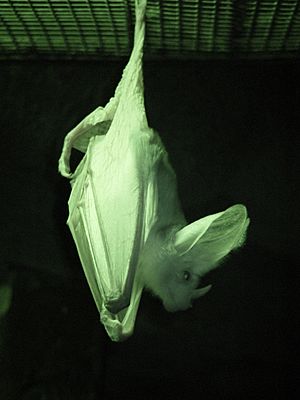False vampire bat facts for kids
The Spectral Bat (Vampyrum spectrum) is a very large bat found in parts of Central and South America. It's known for being the biggest carnivorous bat in the world! Even though its name might sound a bit scary, like "vampire," it doesn't drink blood. Instead, it's a skilled hunter that eats other animals.
Quick facts for kids Spectral Bat |
|
|---|---|
 |
|
| Scientific classification | |
| Kingdom: | |
| Phylum: | |
| Class: | |
| Order: | |
| Family: | |
| Genus: |
Vampyrum
|
Contents
About the Spectral Bat
The Spectral Bat is the largest bat in the New World (North and South America). It's also the biggest bat that eats meat. Its wings can spread out from about 60 to 91.5 centimeters (2 to 3 feet) wide. Some very large ones can even reach over 100 centimeters (about 3.3 feet)!
These bats are about 12.5 to 13.5 centimeters (5 to 5.3 inches) long, and they don't have a tail. They weigh between 145 and 190 grams (about 5 to 6.7 ounces). Their fur is usually dark brown, chestnut brown, or rust-orange on top. Their ears are very long and round. They have a special noseleaf, which is a fleshy growth on their nose, that helps them hunt.
Where They Live
Spectral Bats live in a wide area, from southern Mexico all the way down to Peru and Ecuador. You can also find them in central and northern Brazil, Suriname, Guyana, and the island of Trinidad.
They usually rest, or roost, in dense lowland forests. They often hang from tree branches, but sometimes they use hollow trees or even old buildings. They especially like areas near rivers. When they go hunting, they might fly into different places like moist forests, yards, or the edges of woodlands.
What They Eat
The Spectral Bat is an amazing hunter at night. Unlike the true Vampire bats that drink blood, this bat actively hunts and kills its prey. It mainly eats other animals like small birds, small mammals (even other kinds of bats!), and sometimes amphibians and reptiles.
They often choose prey that weighs about the same as they do, from 20 to 150 grams (0.7 to 5.3 ounces). Scientists found the remains of 84 birds of 18 different species at one bat roost. These included birds like motmots and doves. They also eat large insects like crickets and cicadas.
When hunting, these bats are very quiet and sneaky. They fly slowly and close to the ground. They can move very well in the air, even though their flight might look a bit bouncy. They often stalk their prey, then pounce on it from a branch above. They might also fly back and forth along forest edges, like an owl, and suddenly drop onto something in the grass.
Spectral Bats seem to hunt mostly by smell, not by sight or echolocation (the way many bats use sound to "see"). They have been known to be attracted to the distress calls of smaller bats when hunting. Their wings are built to help them fly in tight spaces and carry heavy food.
Life Cycle and Family Life
Spectral Bats usually live in hollow trees with their mate and their young. Not much is known about their breeding habits, but babies have been seen from May to July, when the rainy season begins. Usually, one baby bat, called a pup, is born each year, though sometimes there can be up to three.
The mother bat is very caring and gentle with her baby. The male bat often helps too. He might even sleep with the female and their young, wrapping them completely in his wings. It's thought that these bat pairs might stay together for their whole lives.
Young Spectral Bats can be hunted by animals like tree snakes, coatis, and small wild cats. Adult bats might be caught by owls while flying.
Currently, the Spectral Bat is considered "Near Threatened" in terms of conservation. This is mainly because they rely on mature forests, which are being cut down in some areas where they live.
Images for kids
-
A groove-billed ani, one of the Spectral Bat's main food sources.
See also
 In Spanish: Murciélago espectral para niños
In Spanish: Murciélago espectral para niños







